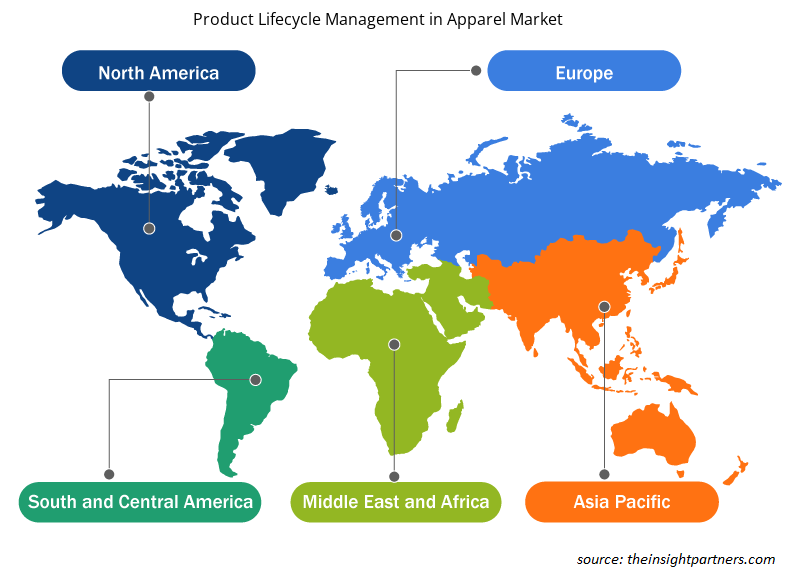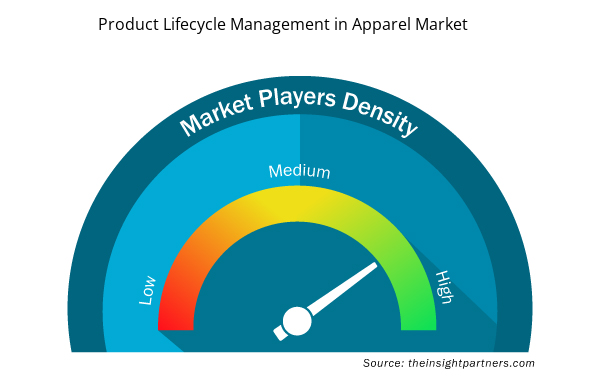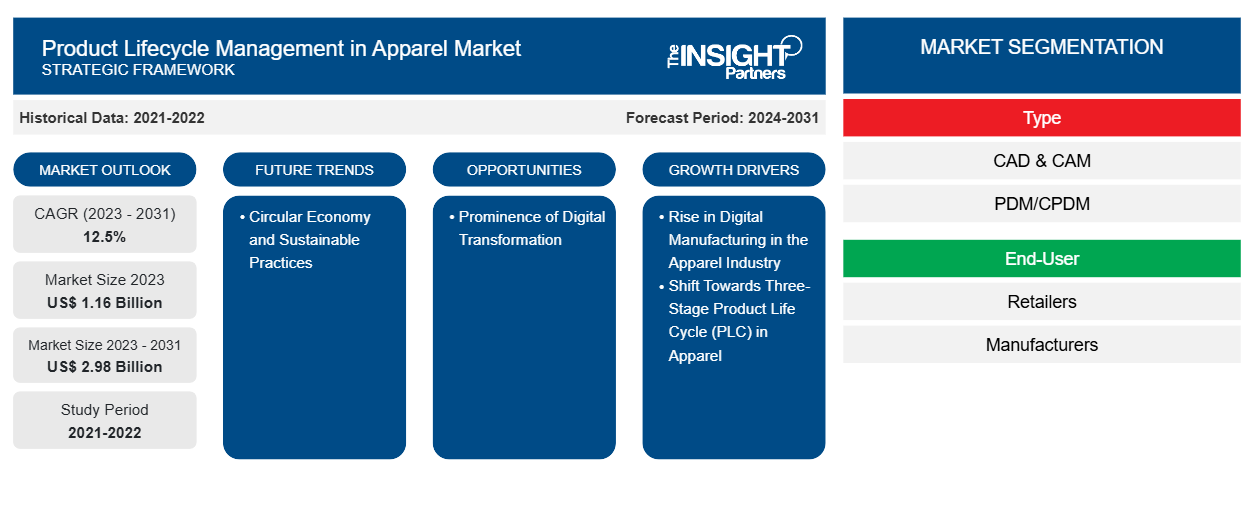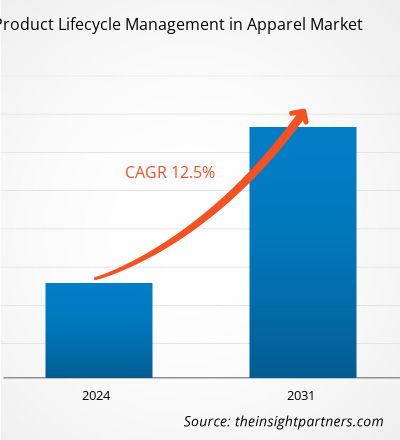アパレル市場における製品ライフサイクル管理の規模は、2023年の11億6,000万米ドルから2031年には29億8,000万米ドルに達すると予測されています。市場は2023年から2031年にかけて12.5%のCAGRを記録すると予想されています。循環型経済と持続可能な慣行、およびデジタル変革への重点は、アパレル市場のトレンドにおける主要な製品ライフサイクル管理であり続けると思われます。
アパレル市場分析における製品ライフサイクル管理
消費者の嗜好の急速な変化と製品寿命の短縮がファッション業界の特徴であり、業界の複雑さが増しています。これらの変化は、製造、生産方法、基準、広告、マーケティング活動など、業界のさまざまな領域で困難と見通しを生み出しています。
アパレル市場における製品ライフサイクル管理の概要
アパレル業界では、製品ライフサイクル管理 (PLM) は、初期の設計と開発から正式な発売、サービス、廃棄まで、製品の全過程を管理する戦略的なアプローチです。この包括的な方法には、製造、マーケティング、市場からの最終的な撤退など、製品のライフサイクルに関連するすべてのアクティビティの管理が含まれます。PLM アプローチを通じて、業界は、売上の大幅な変動など、時間の経過とともに製品が市場でどの程度受け入れられているかを分析できます。
要件に合わせてレポートをカスタマイズする
このレポートの一部、国レベルの分析、Excelデータパックなど、あらゆるレポートを無料でカスタマイズできます。また、スタートアップや大学向けのお得なオファーや割引もご利用いただけます。
- このレポートの主要な市場動向を入手してください。この無料サンプルには、市場動向から見積もりや予測に至るまでのデータ分析が含まれます。
アパレル市場の推進要因と機会における製品ライフサイクル管理
アパレル業界のデジタル製造の台頭が市場を活性化
アパレル業界におけるデジタル製造の台頭は、堅牢で信頼性の高い製品ライフサイクル管理 (PLM) システムの要件に大きな影響を与えると予想されています。これは主に、構想、設計、計画、実行など、デジタル製造に関係する複雑なプロセスによるもので、これらすべてに CAD や CAM などの PLMソフトウェアの広範な使用が必要です。その結果、デジタル製造の拡大により PLM システムのニーズが高まり、予測期間中にアパレル市場における製品ライフサイクル管理の進歩が促進されると予測されています。
デジタルトランスフォーメーションの重要性
デジタル化への継続的な移行により、機械学習 (ML)、人工知能 (AI)、ロボット工学、モノのインターネット (IoT) などの高度なテクノロジーを取り入れ、イノベーションの新たな道が開かれ、第 4 次産業革命 (インダストリー 4.0) の時代へと道が開かれました。インダストリー 4.0 では、電子工学と情報技術を融合することで、現代の人間の生活の物理的、デジタル的、生物学的側面のシームレスなデジタル統合が促進されます。これは、特に衣料品や履物などの大量生産品の生産において、製造業にとって大きな変化であり、インダストリー 4.0 は革命的な変革を引き起こします。
アパレル市場レポートのセグメンテーション分析における製品ライフサイクル管理
アパレル市場分析における製品ライフサイクル管理の導出に貢献した主要なセグメントは、タイプとエンドユーザーです。
- タイプに基づいて、市場はCAD&CAMとPDM / CPDMに分かれています。CAD&CAMセグメントは2023年に大きな市場シェアを占めました。
- エンドユーザーの観点から見ると、市場は小売業者、メーカーなど。メーカー部門は2023年に市場で大きなシェアを占めました。
アパレルにおける製品ライフサイクル管理 地域別市場シェア分析
アパレル市場レポートにおける製品ライフサイクル管理の地理的範囲は、主に北米、アジア太平洋、ヨーロッパ、中東およびアフリカ、南米/中南米の 5 つの地域に分かれています。
ヨーロッパのアパレル市場における製品ライフサイクル管理は、ファッション製品のライフサイクル全体の管理を網羅し、急速に変化するトレンドや消費者の嗜好によって生じる特有の課題に対処します。市場は大幅な成長が見込まれており、変化する市場動向に適応することは、ヨーロッパのアパレル業界の企業にとってチャンスとなります。
アパレル市場における製品ライフサイクル管理の地域分析
予測期間を通じてアパレル市場における製品ライフサイクル管理に影響を与える地域的な傾向と要因は、Insight Partners のアナリストによって徹底的に説明されています。このセクションでは、北米、ヨーロッパ、アジア太平洋、中東、アフリカ、南米、中米にわたるアパレル市場における製品ライフサイクル管理のセグメントと地理についても説明します。

- アパレル市場における製品ライフサイクル管理のための地域固有のデータを入手
アパレル市場における製品ライフサイクル管理レポートの範囲
| レポート属性 | 詳細 |
|---|---|
| 2023年の市場規模 | 11億6千万米ドル |
| 2031年までの市場規模 | 29億8千万米ドル |
| 世界のCAGR(2023年~2031年) | 12.5% |
| 履歴データ | 2021-2022 |
| 予測期間 | 2024-2031 |
| 対象セグメント | タイプ別
|
| 対象地域と国 | 北米
|
| 市場リーダーと主要企業プロフィール |
|
アパレル市場における製品ライフサイクル管理 プレーヤー密度: ビジネスダイナミクスへの影響を理解する
アパレル市場における製品ライフサイクル管理は、消費者の嗜好の変化、技術の進歩、製品の利点に対する認識の高まりなどの要因により、エンドユーザーの需要が高まり、急速に成長しています。需要が高まるにつれて、企業は提供を拡大し、消費者のニーズを満たすために革新し、新たなトレンドを活用し、市場の成長をさらに促進しています。
市場プレーヤー密度とは、特定の市場または業界内で活動している企業または会社の分布を指します。これは、特定の市場スペースに、その規模または総市場価値と比較して、どれだけの競合相手 (市場プレーヤー) が存在するかを示します。
アパレル市場における製品ライフサイクル管理に携わる主要企業は次のとおりです。
- C-DESIGN ファッション
- コンピュータ生成ソリューション
- ダッソー・システムズ
- EFIオプティテックス
- ガーバーテクノロジーLLC
- インフォア株式会社
免責事項:上記の企業は、特定の順序でランク付けされていません。

- アパレル市場における製品ライフサイクル管理のトップキープレーヤーの概要を入手
アパレル市場における製品ライフサイクル管理のニュースと最近の動向
アパレル市場における製品ライフサイクル管理は、重要な企業出版物、協会データ、データベースを含む一次調査と二次調査後の定性的および定量的データを収集することによって評価されます。以下は、市場における動向のリストです。
- ミッションクリティカルなエンタープライズ ソフトウェア ソリューションのグローバル プロバイダーである Aptean は、ファッション、アパレル、フットウェア、繊維、アクセサリー業界向けに設計された専用ソフトウェア ソリューションのプロバイダーである Momentis の買収を発表しました。
(出典:Aptean Inc.、プレスリリース、2024年)
- 業界クラウド企業であるInfor®は本日、ファッション業界の環境データの分析と検証を専門とするテクノロジー企業Made2FlowとInfor製品ライフサイクル管理(PLM)間の専用インターフェースの提供開始を発表しました。このインターフェースにより、生産サプライチェーンの透明性を高めたいと考えている世界的なファッションブランドは、データの処理と完全な可視性を容易に実現できます。特に重要なのは、第1層から第4層にわたるトレーサビリティと影響測定をサポートすることです。
(出典:Infor、プレスリリース、2023年)
アパレル市場における製品ライフサイクル管理レポートの対象範囲と成果物
「アパレルにおける製品ライフサイクル管理の市場規模と予測(2021〜2031年)」レポートでは、以下の分野をカバーする市場の詳細な分析を提供しています。
- 対象範囲に含まれるすべての主要市場セグメントの世界、地域、国レベルでの市場規模と予測
- 市場の動向(推進要因、制約、主要な機会など)
- 今後の主な動向
- 詳細なPEST/ポーターの5つの力とSWOT分析
- 主要な市場動向、主要プレーヤー、規制、最近の市場動向を網羅した世界および地域の市場分析
- 市場集中、ヒートマップ分析、主要プレーヤー、最近の動向を網羅した業界の状況と競争分析
- 詳細な企業プロフィール
- 過去2年間の分析、基準年、CAGRによる予測(7年間)
- PEST分析とSWOT分析
- 市場規模価値/数量 - 世界、地域、国
- 業界と競争環境
- Excel データセット



Report Coverage
Revenue forecast, Company Analysis, Industry landscape, Growth factors, and Trends

Segment Covered
This text is related
to segments covered.

Regional Scope
North America, Europe, Asia Pacific, Middle East & Africa, South & Central America

Country Scope
This text is related
to country scope.
よくある質問
The market was estimated to be US$ 1.16 billion in 2023 and is expected to grow at a CAGR of 12.5% during the forecast period 2023 - 2031.
The growth in digital manufacturing in the apparel industry is the major factor that propels product lifecycle management in apparel market.
Circular economy and sustainable practices are anticipated to play a significant role in the product lifecycle management in apparel market in the coming years.
The key players in the market are C-DESIGN Fashion, Computer Generated Solution, Dassault Systemes, EFI Optitex, and Gerber Technology LLC.
The market is expected to reach US$ 2.98 billion by 2031.
Trends and growth analysis reports related to Technology, Media and Telecommunications : READ MORE..
The Insight Partners performs research in 4 major stages: Data Collection & Secondary Research, Primary Research, Data Analysis and Data Triangulation & Final Review.
- Data Collection and Secondary Research:
As a market research and consulting firm operating from a decade, we have published and advised several client across the globe. First step for any study will start with an assessment of currently available data and insights from existing reports. Further, historical and current market information is collected from Investor Presentations, Annual Reports, SEC Filings, etc., and other information related to company’s performance and market positioning are gathered from Paid Databases (Factiva, Hoovers, and Reuters) and various other publications available in public domain.
Several associations trade associates, technical forums, institutes, societies and organization are accessed to gain technical as well as market related insights through their publications such as research papers, blogs and press releases related to the studies are referred to get cues about the market. Further, white papers, journals, magazines, and other news articles published in last 3 years are scrutinized and analyzed to understand the current market trends.
- Primary Research:
The primarily interview analysis comprise of data obtained from industry participants interview and answers to survey questions gathered by in-house primary team.
For primary research, interviews are conducted with industry experts/CEOs/Marketing Managers/VPs/Subject Matter Experts from both demand and supply side to get a 360-degree view of the market. The primary team conducts several interviews based on the complexity of the markets to understand the various market trends and dynamics which makes research more credible and precise.
A typical research interview fulfils the following functions:
- Provides first-hand information on the market size, market trends, growth trends, competitive landscape, and outlook
- Validates and strengthens in-house secondary research findings
- Develops the analysis team’s expertise and market understanding
Primary research involves email interactions and telephone interviews for each market, category, segment, and sub-segment across geographies. The participants who typically take part in such a process include, but are not limited to:
- Industry participants: VPs, business development managers, market intelligence managers and national sales managers
- Outside experts: Valuation experts, research analysts and key opinion leaders specializing in the electronics and semiconductor industry.
Below is the breakup of our primary respondents by company, designation, and region:

Once we receive the confirmation from primary research sources or primary respondents, we finalize the base year market estimation and forecast the data as per the macroeconomic and microeconomic factors assessed during data collection.
- Data Analysis:
Once data is validated through both secondary as well as primary respondents, we finalize the market estimations by hypothesis formulation and factor analysis at regional and country level.
- Macro-Economic Factor Analysis:
We analyse macroeconomic indicators such the gross domestic product (GDP), increase in the demand for goods and services across industries, technological advancement, regional economic growth, governmental policies, the influence of COVID-19, PEST analysis, and other aspects. This analysis aids in setting benchmarks for various nations/regions and approximating market splits. Additionally, the general trend of the aforementioned components aid in determining the market's development possibilities.
- Country Level Data:
Various factors that are especially aligned to the country are taken into account to determine the market size for a certain area and country, including the presence of vendors, such as headquarters and offices, the country's GDP, demand patterns, and industry growth. To comprehend the market dynamics for the nation, a number of growth variables, inhibitors, application areas, and current market trends are researched. The aforementioned elements aid in determining the country's overall market's growth potential.
- Company Profile:
The “Table of Contents” is formulated by listing and analyzing more than 25 - 30 companies operating in the market ecosystem across geographies. However, we profile only 10 companies as a standard practice in our syndicate reports. These 10 companies comprise leading, emerging, and regional players. Nonetheless, our analysis is not restricted to the 10 listed companies, we also analyze other companies present in the market to develop a holistic view and understand the prevailing trends. The “Company Profiles” section in the report covers key facts, business description, products & services, financial information, SWOT analysis, and key developments. The financial information presented is extracted from the annual reports and official documents of the publicly listed companies. Upon collecting the information for the sections of respective companies, we verify them via various primary sources and then compile the data in respective company profiles. The company level information helps us in deriving the base number as well as in forecasting the market size.
- Developing Base Number:
Aggregation of sales statistics (2020-2022) and macro-economic factor, and other secondary and primary research insights are utilized to arrive at base number and related market shares for 2022. The data gaps are identified in this step and relevant market data is analyzed, collected from paid primary interviews or databases. On finalizing the base year market size, forecasts are developed on the basis of macro-economic, industry and market growth factors and company level analysis.
- Data Triangulation and Final Review:
The market findings and base year market size calculations are validated from supply as well as demand side. Demand side validations are based on macro-economic factor analysis and benchmarks for respective regions and countries. In case of supply side validations, revenues of major companies are estimated (in case not available) based on industry benchmark, approximate number of employees, product portfolio, and primary interviews revenues are gathered. Further revenue from target product/service segment is assessed to avoid overshooting of market statistics. In case of heavy deviations between supply and demand side values, all thes steps are repeated to achieve synchronization.
We follow an iterative model, wherein we share our research findings with Subject Matter Experts (SME’s) and Key Opinion Leaders (KOLs) until consensus view of the market is not formulated – this model negates any drastic deviation in the opinions of experts. Only validated and universally acceptable research findings are quoted in our reports.
We have important check points that we use to validate our research findings – which we call – data triangulation, where we validate the information, we generate from secondary sources with primary interviews and then we re-validate with our internal data bases and Subject matter experts. This comprehensive model enables us to deliver high quality, reliable data in shortest possible time.


 このレポートの無料サンプルを入手する
このレポートの無料サンプルを入手する